A Multi-Scale Time–Frequency Complementary Load Forecasting Method for Integrated Energy Systems
Abstract
1. Introduction
- (I)
- This study proposes the ST-ScaleFusion model, which achieves time–frequency complementary modeling through multi-scale temporal decomposition and frequency domain interpolation, thereby enabling the integrated modeling of temporal dynamics and frequency domain characteristics.
- (II)
- This study designs a hierarchical down-sampling and season-trend decoupling module to enhance multi-time-scale feature extraction capabilities, separating seasonal patterns from trend components to improve the interpretability and accuracy of long-term dependencies.
- (III)
- This study constructs a frequency domain interpolation module, realizing long-sequence modeling and noise suppression through complex linear projection in the frequency domain, which mitigates information loss in long-range forecasting and enhances anti-noise robustness.
- (IV)
- This study demonstrates significant superiority over traditional methods in multi-step forecasting tasks, providing an efficient tool for real-time scheduling in Intelligent Energy Systems by balancing prediction accuracy and computational efficiency.
2. Feature Analysis and Methods
2.1. Data Analysis
2.1.1. Data Preprocessing
2.1.2. Data Correlation Analysis
2.2. Methods
2.2.1. Multi-Scale Decomposition Module
2.2.2. Past Feature Mixing Module
2.2.3. Frequency Domain Interpolation Forecasting Module (FI Module)
- Frequency Domain Feature Modeling
- Frequency Domain Interpolation Module
- Time Domain Mapping Module
3. Results of Experiment
3.1. Experimental Data Processing
3.2. Comparative Experiment
3.3. Comparison of Error Metrics
3.4. Ablation Experiment
4. Discussion
5. Conclusions
Author Contributions
Funding
Data Availability Statement
Conflicts of Interest
References
- Zhu, L.; Wang, X.; Ma, J.; Chen, Q.; Qi, X. Short-term load forecast of integrated energy system based on wavelet packet decomposition and recurrent neural network. Electr. Power Constr. 2020, 41, 131–138. [Google Scholar]
- Duan, P.; Zhao, B.; Zhang, X.; Fen, M. A day-ahead optimal operation strategy for integrated energy systems in multi-public buildings based on cooperative game. Energy 2023, 275, 127395. [Google Scholar] [CrossRef]
- Wu, K.; Wu, J.; Feng, L.; Yang, B.; Liang, R.; Yang, S.; Zhao, R. An attention-based CNN LSTM-BiLSTM model for short-term electric load forecasting in integrated energy system. Int. Trans. Electr. Energy Syst. 2021, 31, e12637. [Google Scholar] [CrossRef]
- Hu, Y.J.; Zhang, R.; Wang, H.L.; Li, C.J.; Tang, B.J. Synergizing policies for carbon reduction, energy transition and pollution control: Evidence from Chinese power generation industry. J. Clean. Prod. 2024, 436, 140460. [Google Scholar] [CrossRef]
- Wattenburg, W.H. Utility scale compressed air energy storage and clean power using waste heat from thermal power plants plus added protection for nuclear power plants. IEEE Access 2018, 6, 34422–34430. [Google Scholar] [CrossRef]
- Zhu, J.; Dong, H.; Zheng, W.; Li, S.; Huang, Y.; Xi, L. Review and prospect of data-driven techniques for load forecasting in integrated energy systems. Appl. Energy 2022, 321, 119269. [Google Scholar] [CrossRef]
- Huang, R.; Zhu, L.; Gao, F.; Wang, Y.; Yang, Y.; Xiong, X. Short-term power load forecasting method based on variational modal decomposition for convolutional long-short-term memory network. Mod. Electr. Power 2022, 30, 100622. [Google Scholar]
- Xiao, L.; Wang, J.; Yang, X.; Xiao, L. A hybrid model based on data preprocessing for electrical power forecasting. Int. J. Electr. Power Energy Syst. 2015, 64, 311–327. [Google Scholar] [CrossRef]
- Dudek, G. Pattern-based local linear regression models for short-term load forecasting. Electr. Power Syst. Res. 2016, 130, 139–147. [Google Scholar] [CrossRef]
- Nigitz, T.; Goumllles, M. A generally applicable, simple and adaptive forecasting method for the short-term heat load of consumers. Appl. Energy 2019, 241, 73–81. [Google Scholar] [CrossRef]
- Laouafi, A.; Mordjaoui, M.; Laouafi, F.; Boukelia, T.E. Daily peak electricity demand forecasting based on an adaptive hybrid two-stage methodology. Int. J. Electr. Power Energy Syst. 2016, 77, 136–144. [Google Scholar] [CrossRef]
- Lee, C.M.; Ko, C.N. Short-term load forecasting using lifting scheme and ARIMA models. Expert Syst. Appl. 2011, 38, 5902–5911. [Google Scholar] [CrossRef]
- Cheng, P.; Xia, M.; Wang, D.; Lin, H.; Zhao, Z. Transformer Self-Attention Change Detection Network with Frozen Parameters. Appl. Sci. 2025, 15, 3349. [Google Scholar] [CrossRef]
- Zhan, Z.; Ren, H.; Xia, M.; Lin, H.; Wang, X.; Li, X. Amfnet: Attention-guided multi-scale fusion network for bi-temporal change detection in remote sensing images. Remote Sens. 2024, 16, 1765. [Google Scholar] [CrossRef]
- Wang, Z.; Gu, G.; Xia, M.; Weng, L.; Hu, K. Bitemporal attention sharing network for remote sensing image change detection. IEEE J. Sel. Top. Appl. Earth Obs. Remote Sens. 2024, 17, 10368–10379. [Google Scholar] [CrossRef]
- Jiang, S.; Lin, H.; Ren, H.; Hu, Z.; Weng, L.; Xia, M. Mdanet: A high-resolution city change detection network based on difference and attention mechanisms under multi-scale feature fusion. Remote Sens. 2024, 16, 1387. [Google Scholar] [CrossRef]
- Wang, C.; Wang, Y.; Ding, Z.; Zheng, T.; Hu, J.; Zhang, K. A transformer-based method of multienergy load forecasting in integrated energy system. IEEE Trans. Smart Grid 2022, 13, 2703–2714. [Google Scholar] [CrossRef]
- Li, K.; Mu, Y.; Yang, F.; Wang, H.; Yan, Y.; Zhang, C. A novel short-term multi-energy load forecasting method for integrated energy system based on feature separation-fusion technology and improved CNN. Appl. Energy 2023, 351, 121823. [Google Scholar] [CrossRef]
- Huang, N.; Wang, S.; Wang, R.; Cai, G.; Liu, Y.; Dai, Q. Gated spatial-temporal graph neural network based short-term load forecasting for wide-area multiple buses. Int. J. Electr. Power Energy Syst. 2023, 145, 108651. [Google Scholar] [CrossRef]
- Zhang, Y.; Wen, H.; Wu, Q.; Ai, Q. Optimal adaptive prediction intervals for electricity load forecasting in distribution systems via reinforcement learning. IEEE Trans. Smart Grid 2022, 14, 3259–3270. [Google Scholar] [CrossRef]
- Chen, H.; Huang, H.; Zheng, Y.; Yang, B. A load forecasting approach for integrated energy systems based on aggregation hybrid modal decomposition and combined model. Appl. Energy 2024, 375, 124166. [Google Scholar] [CrossRef]
- Wu, H.; Xu, Z. Multi-energy flow calculation in integrated energy system via topological graph attention convolutional network with transfer learning. Energy 2024, 303, 132018. [Google Scholar] [CrossRef]
- Wang, C.; Wang, Y.; Ding, Z.; Zhang, K. Probabilistic multi-energy load forecasting for integrated energy system based on Bayesian transformer network. IEEE Trans. Smart Grid 2023, 15, 1495–1508. [Google Scholar] [CrossRef]
- Zhuang, W.; Fan, J.; Xia, M.; Zhu, K. A multi-scale spatial–temporal graph neural network-based method of multienergy load forecasting in integrated energy system. IEEE Trans. Smart Grid 2023, 15, 2652–2666. [Google Scholar] [CrossRef]
- Yan, Y.; Wang, X.; Li, K.; Li, C.; Tian, C.; Shao, Z.; Li, J. Stochastic optimization of district integrated energy systems based on a hybrid probability forecasting model. Energy 2024, 306, 132486. [Google Scholar] [CrossRef]
- Li, K.; Duan, P.; Cao, X.; Cheng, Y.; Zhao, B.; Xue, Q.; Feng, M. A multi-energy load forecasting method based on complementary ensemble empirical model decomposition and composite evaluation factor reconstruction. Appl. Energy 2024, 365, 123283. [Google Scholar] [CrossRef]
- Zhang, Z.; Wang, C.; Wu, Q.; Dong, X. Optimal dispatch for cross-regional integrated energy system with renewable energy uncertainties: A unified spatial-temporal cooperative framework. Energy 2024, 292, 130433. [Google Scholar] [CrossRef]
- Zhang, S.; Pan, G.; Li, B.; Gu, W.; Fu, J.; Sun, Y. Multi-times scale security evaluation and regulation of integrated electricity and heating system. IEEE Trans. Smart Grid 2024, 16, 1088–1099. [Google Scholar] [CrossRef]
- Wu, H.; Xu, J.; Wang, J.; Long, M. Autoformer: Decomposition transformers with auto-correlation for long-term series forecasting. Adv. Neural Inf. Process. Syst. 2021, 34, 22419–22430. [Google Scholar]
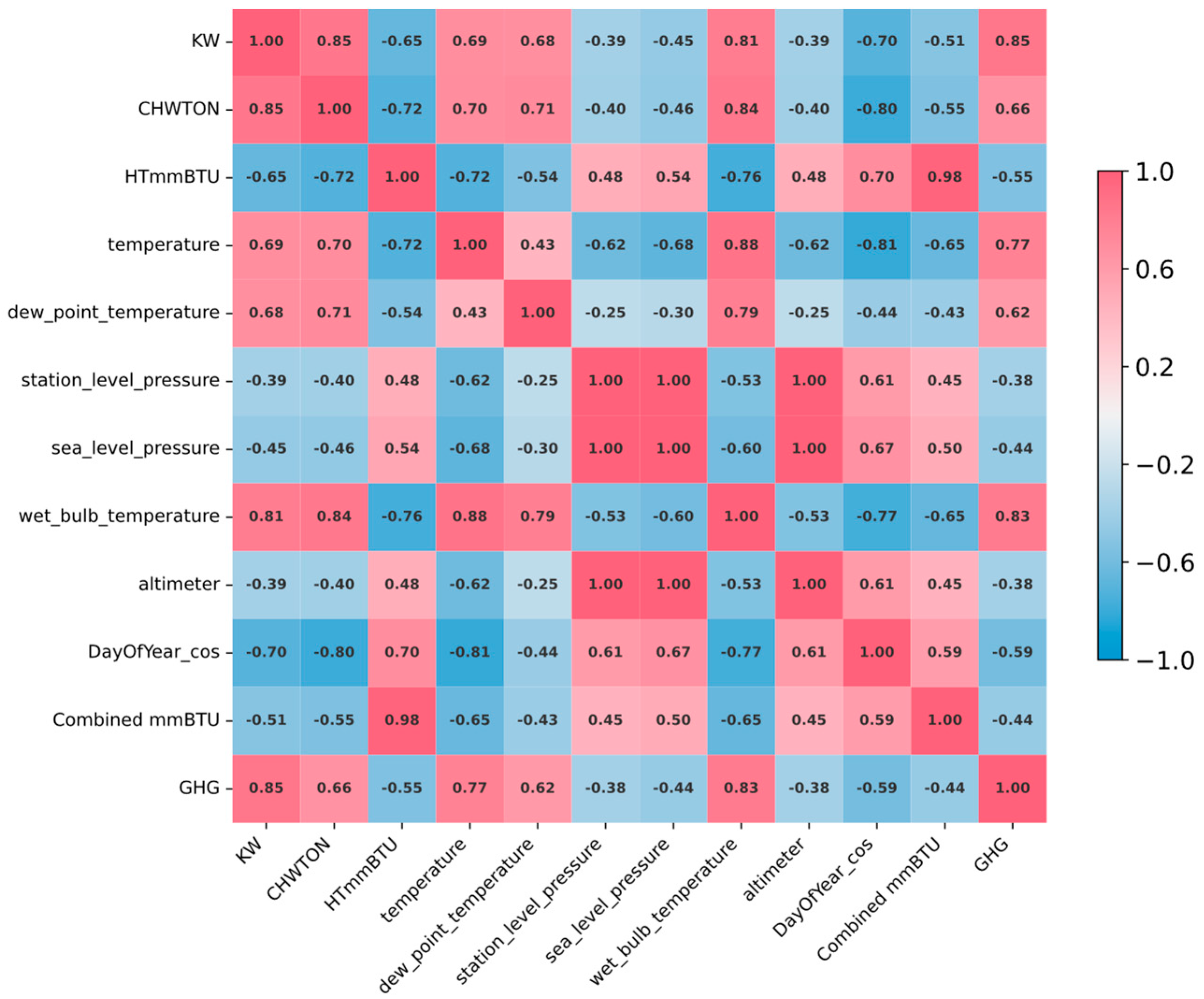
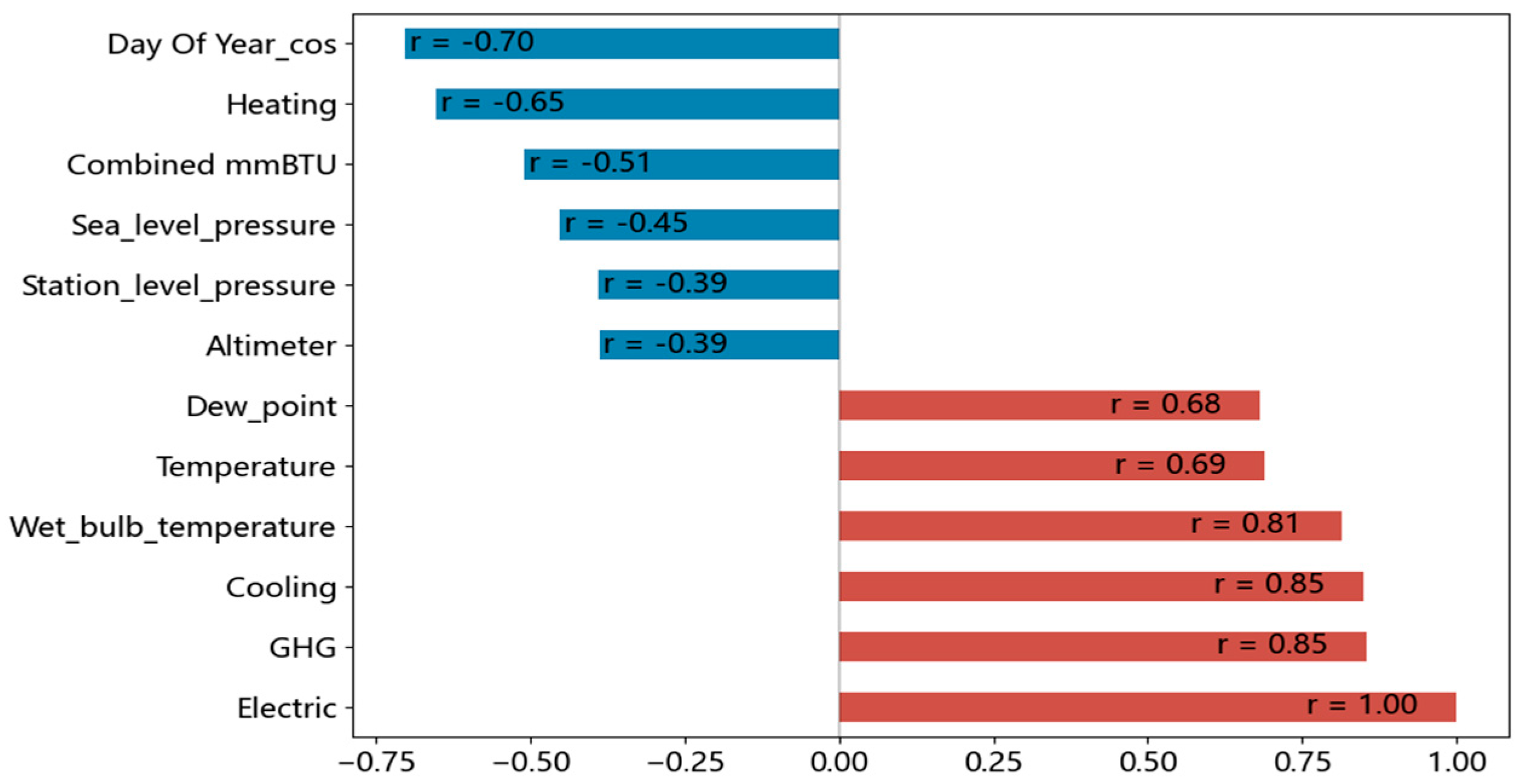
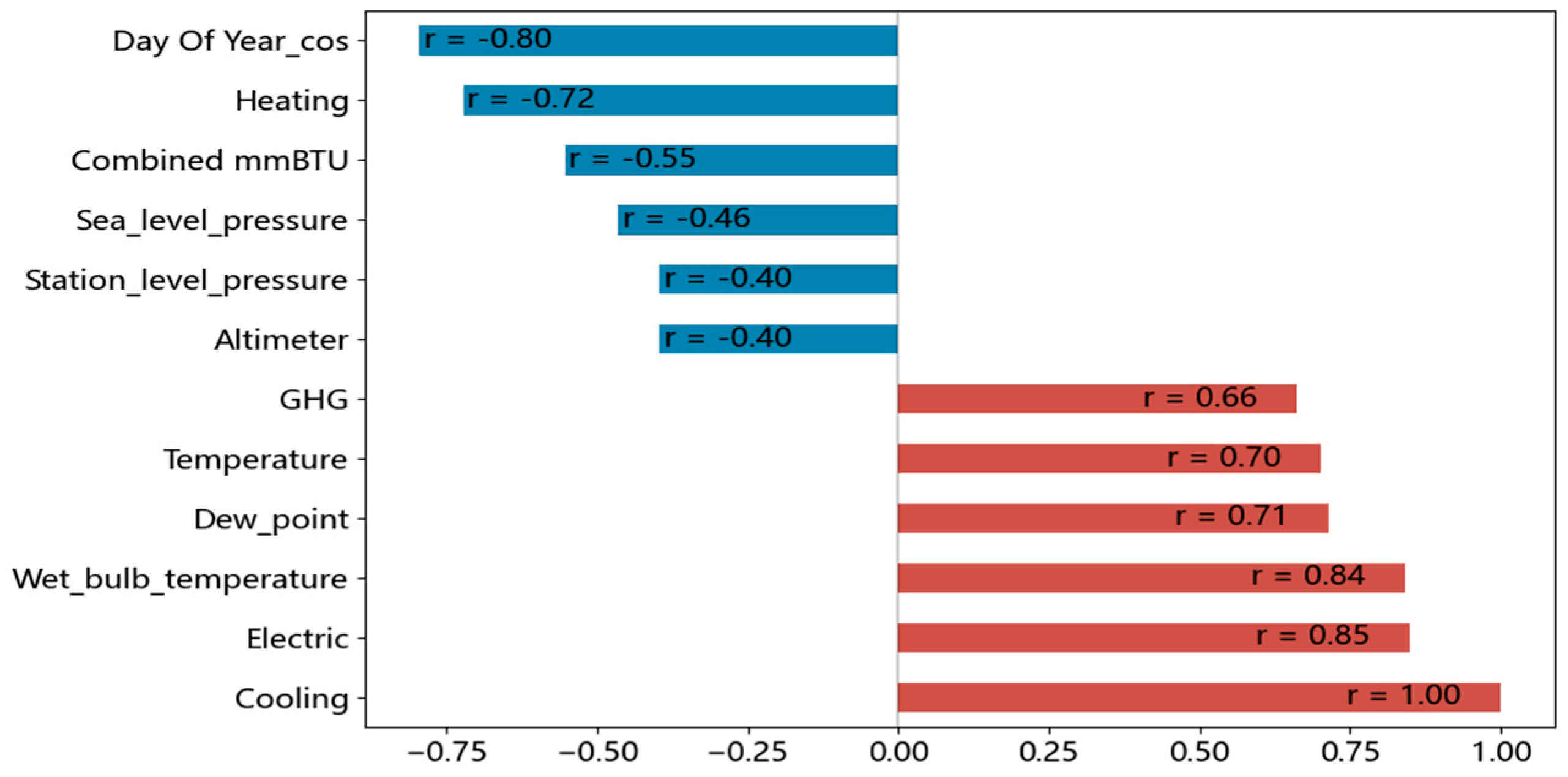
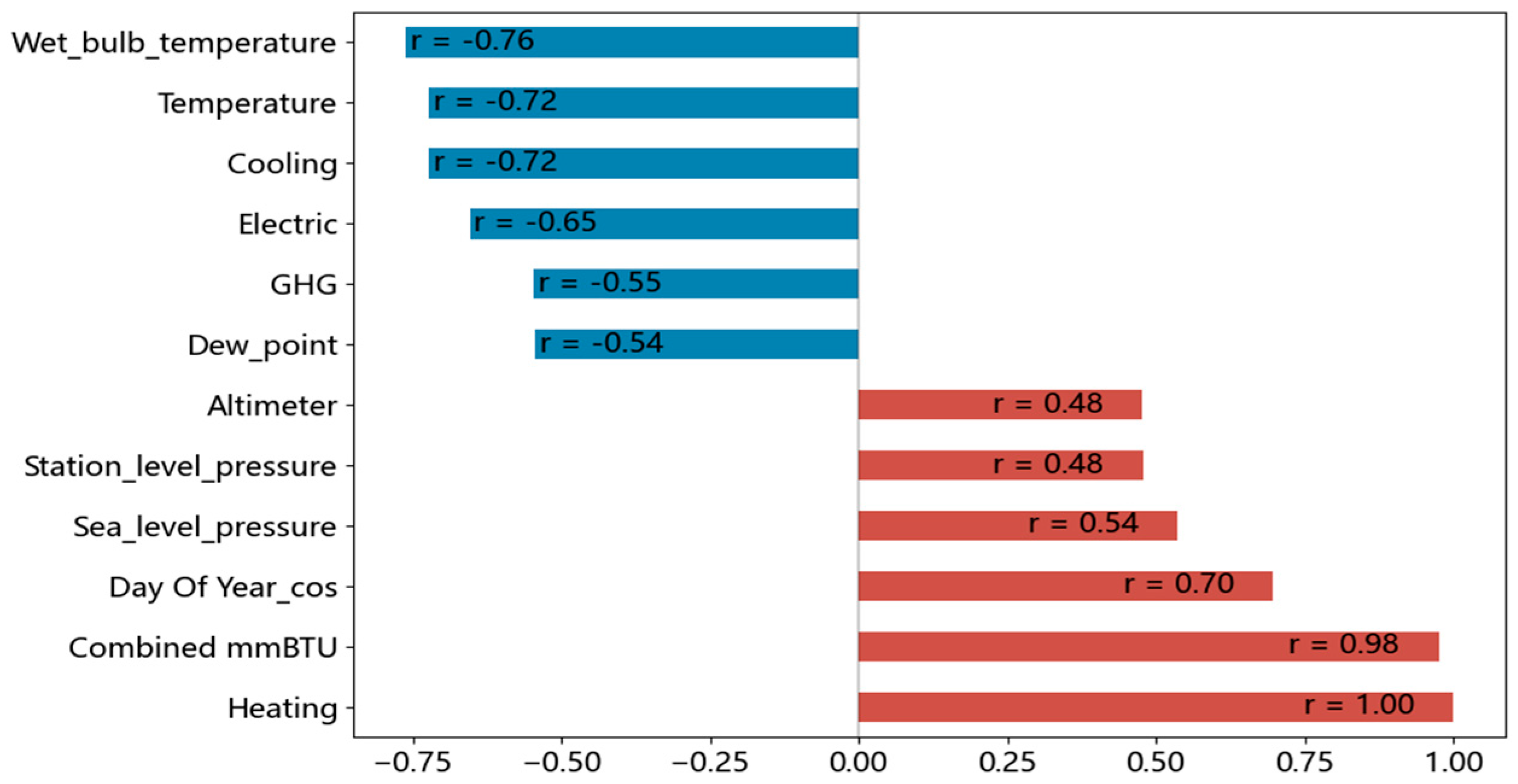
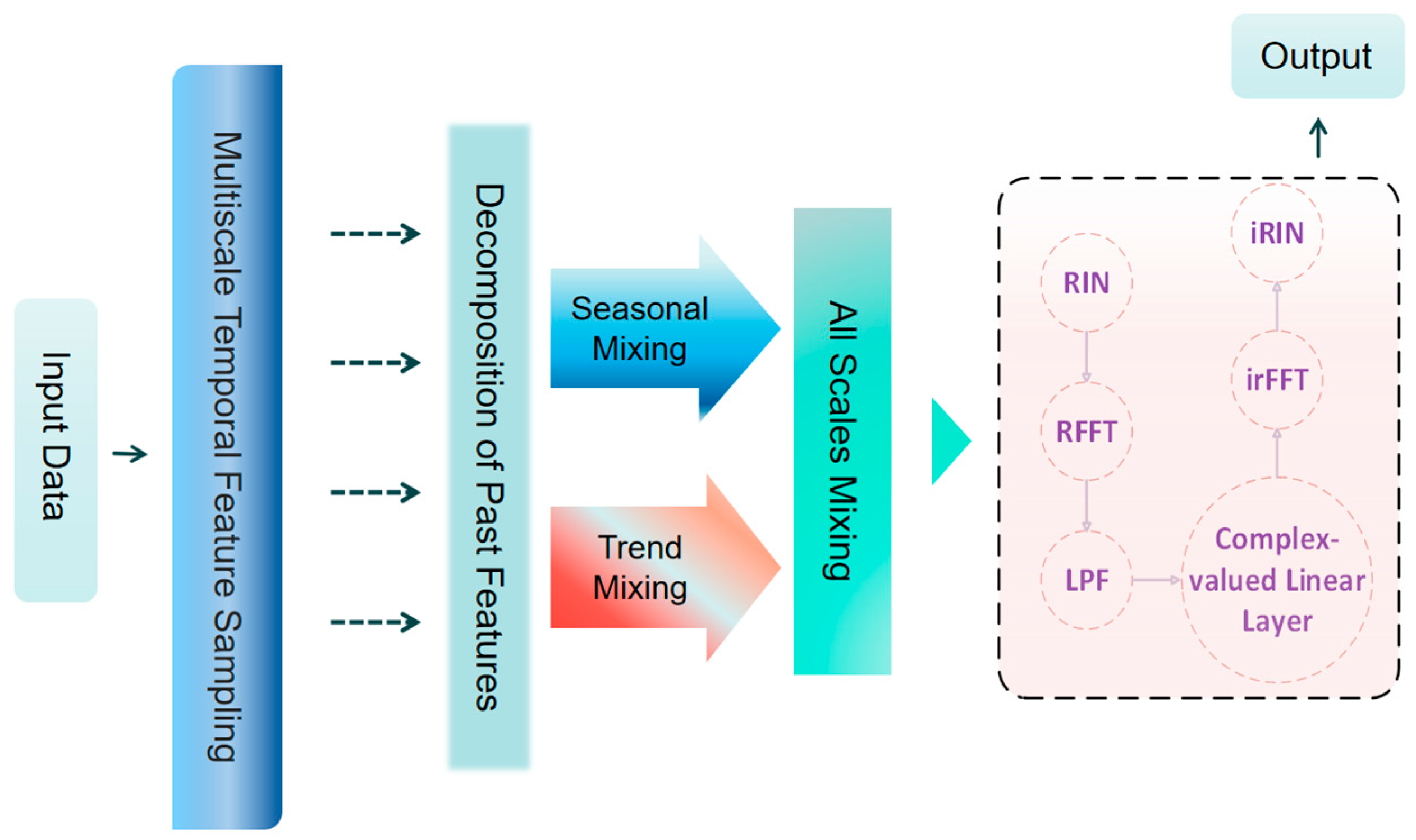


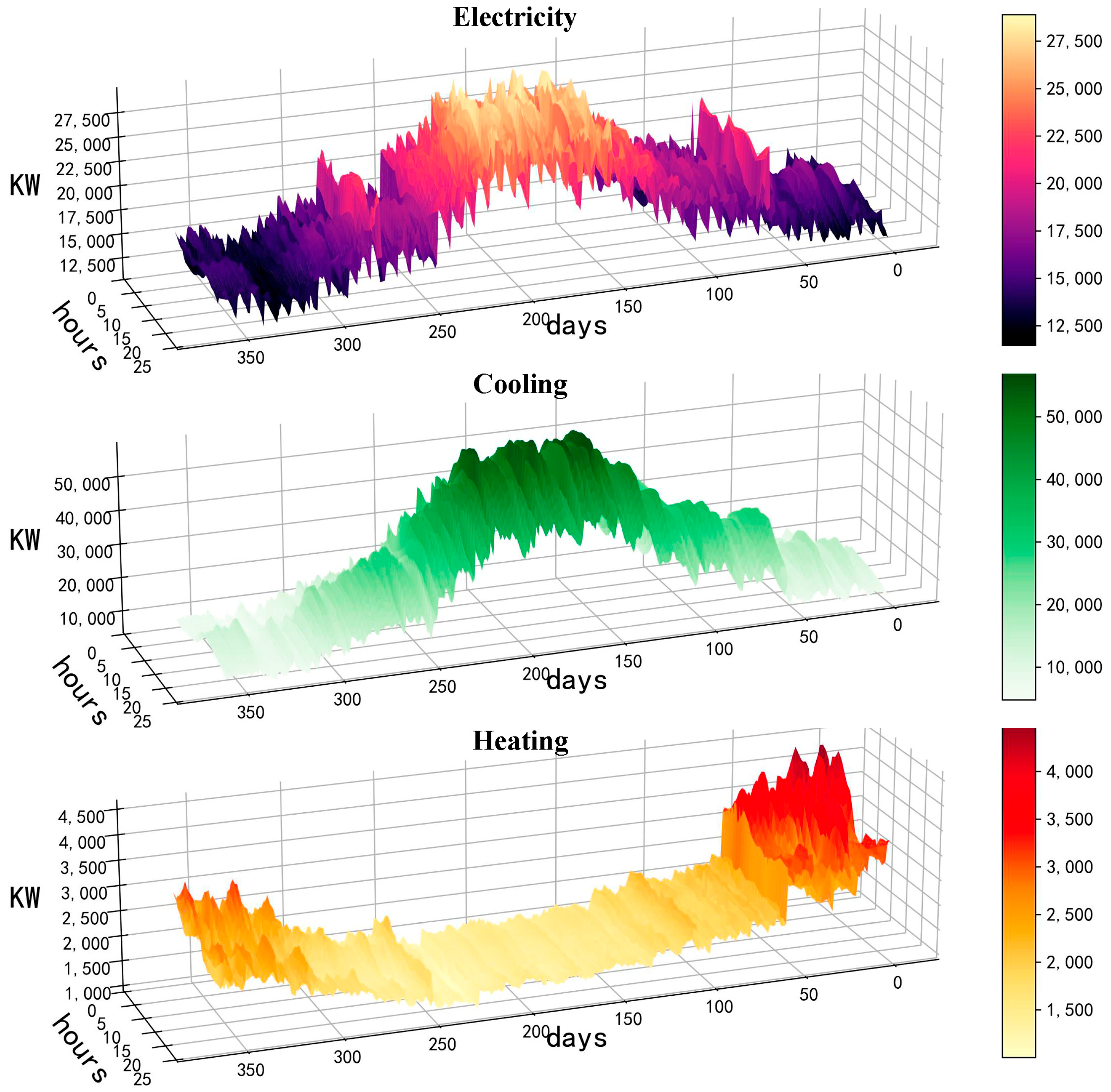
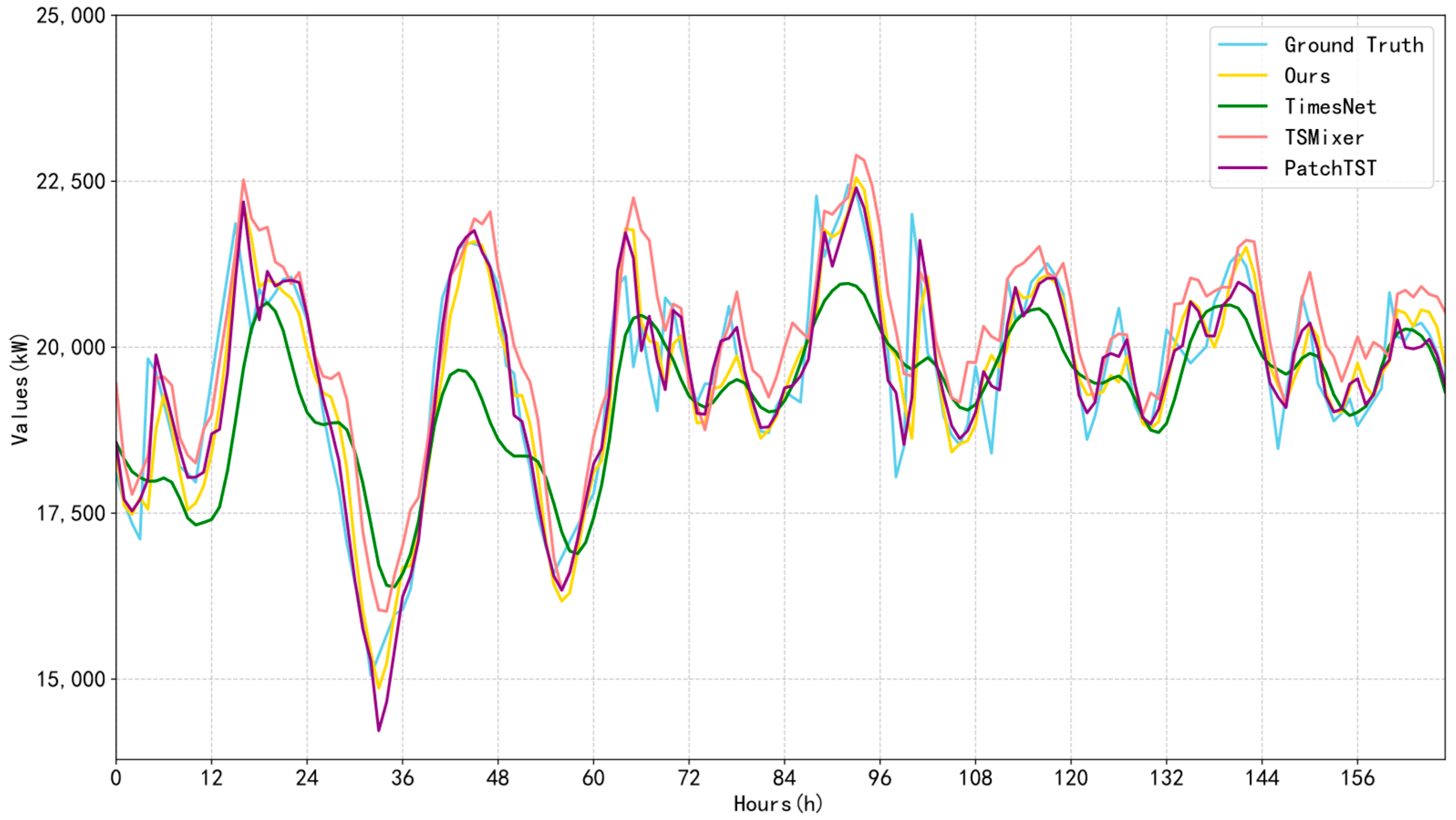
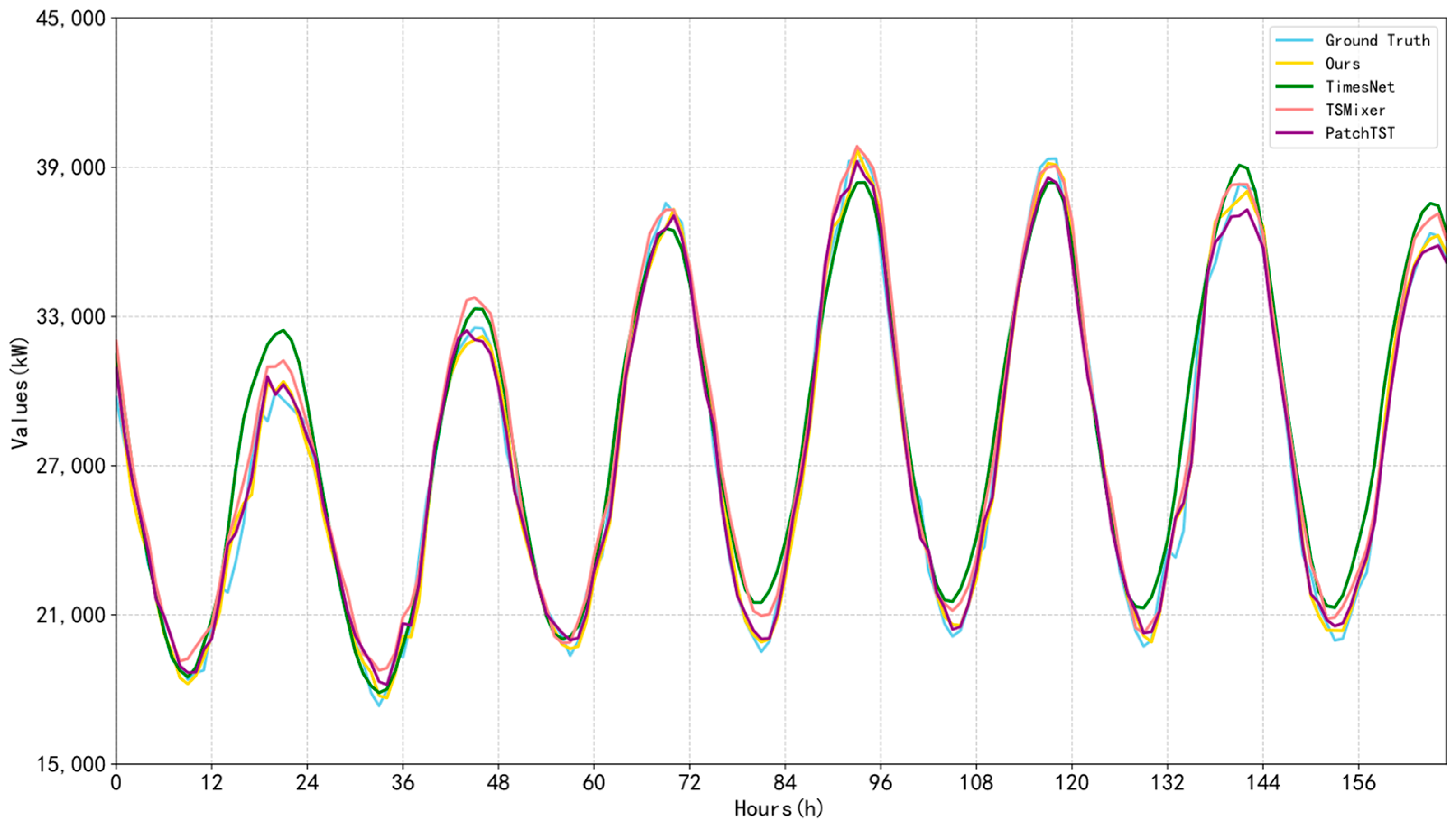
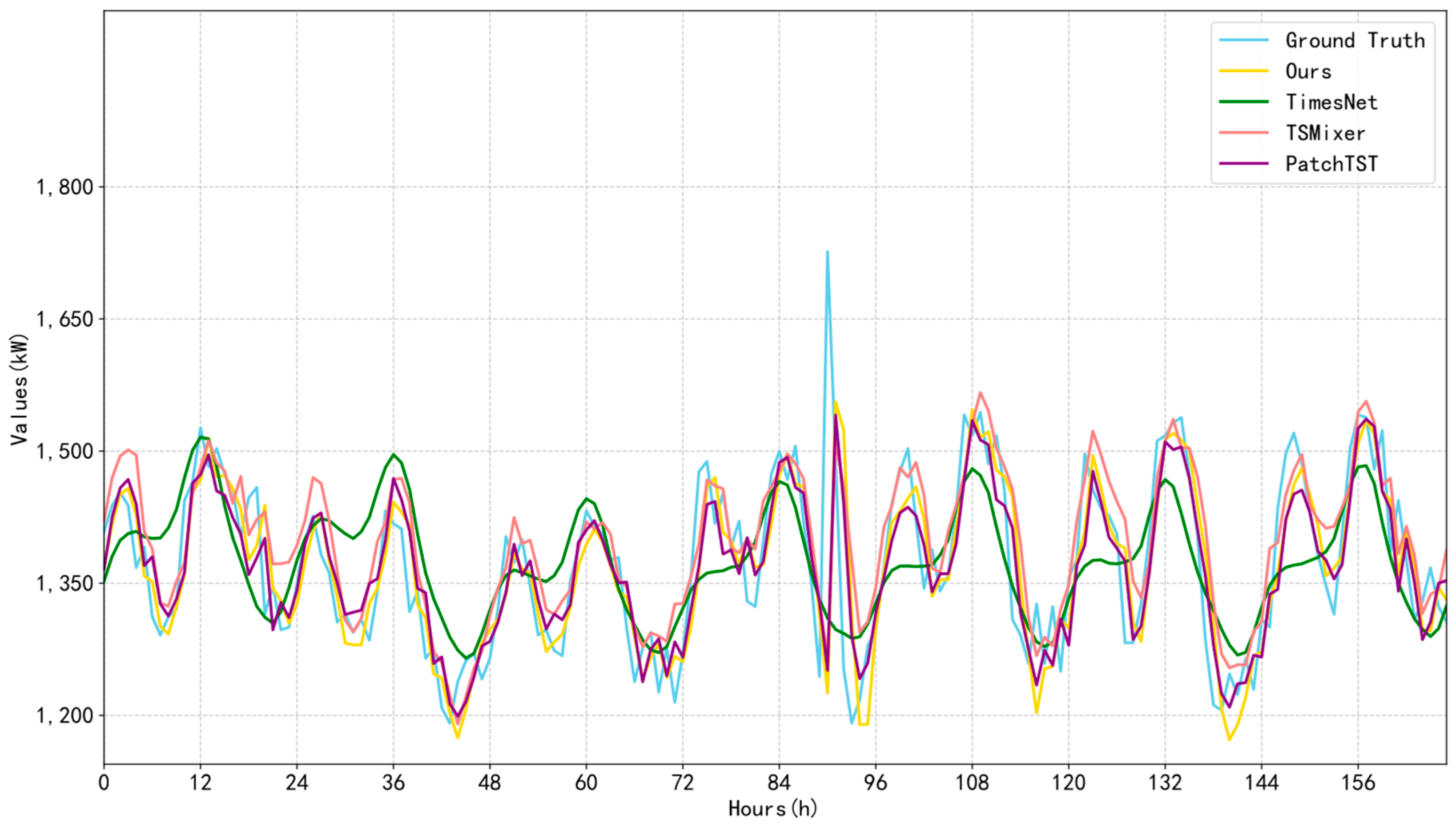
| Models | Total Load | Electrical Load | Cooling Load | Heating Load | |||||||||||||
|---|---|---|---|---|---|---|---|---|---|---|---|---|---|---|---|---|---|
| Horizon | MAE | MAPE | RMSE | ACCR | MAE | MAPE | RMSE | ACCR | MAE | MAPE | RMSE | ACCR | MAE | MAPE | RMSE | ACCR | |
| PatchTST | 24 | 684.7 | 6.16 | 1153.5 | 0.946 | 816.5 | 5.46 | 1238.2 | 0.912 | 1146.3 | 8.08 | 1567.2 | 0.981 | 91.3 | 4.94 | 120.8 | 0.944 |
| 48 | 903.8 | 8.08 | 1529.4 | 0.912 | 1044.5 | 6.85 | 1556.4 | 0.861 | 1548.4 | 10.91 | 2113.8 | 0.966 | 118.7 | 6.47 | 157.8 | 0.909 | |
| 72 | 1044.8 | 9.11 | 1756.7 | 0.887 | 1167.9 | 7.67 | 1735.3 | 0.826 | 1835.2 | 12.52 | 2474.4 | 0.954 | 131.3 | 7.14 | 175.0 | 0.881 | |
| 96 | 1196.4 | 10.43 | 1998.1 | 0.871 | 1290.3 | 8.35 | 1840.0 | 0.803 | 2159.2 | 15.32 | 2898.8 | 0.940 | 139.8 | 7.62 | 184.7 | 0.870 | |
| FiLM | 24 | 709.5 | 6.36 | 1185.3 | 0.941 | 944.6 | 6.40 | 1377.9 | 0.890 | 1097.1 | 7.85 | 1521.9 | 0.981 | 87.0 | 4.83 | 119.0 | 0.950 |
| 48 | 878.4 | 7.60 | 1489.7 | 0.916 | 1052.2 | 6.98 | 1554.8 | 0.857 | 1474.6 | 10.32 | 2027.0 | 0.967 | 108.3 | 5.50 | 143.6 | 0.924 | |
| 72 | 1030.7 | 9.06 | 1728.8 | 0.896 | 1180.3 | 7.79 | 1719.4 | 0.824 | 1789.0 | 12.89 | 2409.0 | 0.957 | 122.7 | 6.52 | 162.7 | 0.908 | |
| 96 | 1145.4 | 10.21 | 1887.9 | 0.880 | 1273.7 | 8.41 | 1817.3 | 0.803 | 2027.8 | 14.45 | 2676.0 | 0.946 | 134.8 | 7.78 | 177.5 | 0.891 | |
| NLinear | 24 | 672.1 | 6.07 | 1134.4 | 0.946 | 856.9 | 5.81 | 1267.8 | 0.908 | 1072.6 | 7.57 | 1484.9 | 0.983 | 86.7 | 4.82 | 116.7 | 0.948 |
| 48 | 881.9 | 7.70 | 1508.9 | 0.917 | 1060.5 | 7.10 | 1569.9 | 0.856 | 1479.9 | 10.37 | 2062.2 | 0.969 | 105.3 | 5.64 | 142.8 | 0.925 | |
| 72 | 1037.2 | 9.08 | 1742.8 | 0.895 | 1192.7 | 7.89 | 1731.1 | 0.823 | 1799.3 | 12.68 | 2432.6 | 0.956 | 119.7 | 6.66 | 159.7 | 0.906 | |
| 96 | 1155.3 | 9.99 | 1908.6 | 0.879 | 1286.2 | 8.60 | 1836.1 | 0.801 | 2048.1 | 14.39 | 2721.1 | 0.947 | 131.4 | 6.99 | 175.3 | 0.890 | |
| TimesNet | 24 | 770.9 | 6.94 | 1244.4 | 0.933 | 1024.5 | 6.88 | 1443.6 | 0.881 | 1188.8 | 7.97 | 1594.8 | 0.983 | 99.3 | 5.98 | 126.5 | 0.935 |
| 48 | 960.0 | 8.30 | 1598.7 | 0.906 | 1178.6 | 7.96 | 1652.7 | 0.838 | 1587.0 | 10.45 | 2176.2 | 0.968 | 114.2 | 6.48 | 147.8 | 0.914 | |
| 72 | 1064.0 | 8.94 | 1742.7 | 0.896 | 1278.7 | 8.60 | 1728.7 | 0.819 | 1794.7 | 11.56 | 2423.2 | 0.956 | 118.5 | 6.65 | 149.8 | 0.913 | |
| 96 | 1312.2 | 10.58 | 2173.3 | 0.859 | 1449.9 | 9.47 | 1978.8 | 0.764 | 2348.4 | 14.57 | 3060.7 | 0.933 | 138.3 | 7.69 | 174.9 | 0.880 | |
| TimeXer | 24 | 700.1 | 6.25 | 1197.5 | 0.947 | 795.5 | 5.56 | 1218.3 | 0.916 | 1218.3 | 8.35 | 1672.9 | 0.979 | 86.5 | 4.82 | 118.4 | 0.946 |
| 48 | 924.0 | 7.99 | 1591.8 | 0.916 | 984.4 | 6.78 | 1498.5 | 0.870 | 1679.5 | 11.42 | 2319.2 | 0.959 | 108.0 | 5.78 | 144.3 | 0.920 | |
| 72 | 1052.8 | 9.06 | 1795.2 | 0.895 | 1115.4 | 7.44 | 1698.8 | 0.835 | 1923.4 | 13.28 | 2649.3 | 0.947 | 119.6 | 6.46 | 158.4 | 0.904 | |
| 96 | 1172.5 | 10.07 | 1978.2 | 0.875 | 1196.3 | 7.79 | 1787.4 | 0.806 | 2188.7 | 15.37 | 2934.6 | 0.935 | 132.3 | 7.06 | 172.7 | 0.885 | |
| TSMixer | 24 | 702.7 | 6.38 | 1185.7 | 0.942 | 897.1 | 5.99 | 1329.5 | 0.901 | 1123.4 | 8.32 | 1563.4 | 0.983 | 87.6 | 4.83 | 116.7 | 0.942 |
| 48 | 919.5 | 7.80 | 1524.0 | 0.914 | 1063.0 | 7.00 | 1594.0 | 0.852 | 1587.4 | 10.53 | 2056.7 | 0.969 | 108.2 | 5.88 | 142.8 | 0.921 | |
| 72 | 1049.0 | 8.54 | 1744.3 | 0.898 | 1198.8 | 7.89 | 1781.1 | 0.821 | 1835.5 | 11.59 | 2448.1 | 0.960 | 112.8 | 6.13 | 148.6 | 0.913 | |
| 96 | 1184.4 | 9.76 | 1917.2 | 0.880 | 1298.2 | 8.69 | 1892.4 | 0.793 | 2132.7 | 13.84 | 2774.5 | 0.948 | 122.3 | 6.75 | 159.8 | 0.898 | |
| iTransformer | 24 | 696.4 | 6.15 | 1159.4 | 0.946 | 831.8 | 5.48 | 1246.5 | 0.915 | 1165.6 | 7.99 | 1567.7 | 0.982 | 91.8 | 4.98 | 124.4 | 0.941 |
| 48 | 948.0 | 8.09 | 1604.3 | 0.911 | 1066.2 | 6.97 | 1589.4 | 0.854 | 1667.8 | 11.35 | 2278.9 | 0.962 | 110.0 | 5.94 | 148.4 | 0.917 | |
| 72 | 1105.3 | 9.55 | 1833.1 | 0.889 | 1201.2 | 7.78 | 1745.4 | 0.823 | 1989.4 | 13.98 | 2666.1 | 0.950 | 125.1 | 6.90 | 169.8 | 0.895 | |
| 96 | 1187.2 | 10.27 | 1962.1 | 0.874 | 1260.8 | 8.15 | 1812.5 | 0.805 | 2167.4 | 15.25 | 2869.1 | 0.940 | 133.5 | 7.42 | 178.8 | 0.877 | |
| Crossformer | 24 | 699.7 | 5.99 | 1141.1 | 0.947 | 867.6 | 5.66 | 1265.5 | 0.907 | 1145.7 | 7.57 | 1514.6 | 0.983 | 85.7 | 4.73 | 113.3 | 0.950 |
| 48 | 933.7 | 7.60 | 1560.7 | 0.914 | 1109.7 | 7.29 | 1578.7 | 0.851 | 1581.8 | 10.22 | 2188.4 | 0.966 | 109.5 | 5.29 | 144.0 | 0.925 | |
| 72 | 1027.2 | 8.54 | 1689.8 | 0.899 | 1188.2 | 7.79 | 1688.2 | 0.828 | 1778.7 | 11.40 | 2398.0 | 0.955 | 114.8 | 6.44 | 148.2 | 0.916 | |
| 96 | 1243.7 | 10.23 | 2082.1 | 0.872 | 1319.0 | 8.42 | 1883.3 | 0.785 | 2268.6 | 14.35 | 3079.5 | 0.933 | 143.5 | 7.93 | 188.0 | 0.896 | |
| SparseTSF | 24 | 831.5 | 7.18 | 1364.3 | 0.927 | 1032.6 | 6.95 | 1528.4 | 0.868 | 1367.8 | 9.53 | 1807.7 | 0.976 | 94.1 | 5.06 | 128.1 | 0.937 |
| 48 | 1033.0 | 8.86 | 1698.9 | 0.896 | 1229.5 | 8.29 | 1791.3 | 0.816 | 1757.9 | 12.30 | 2345.1 | 0.959 | 111.6 | 5.98 | 149.2 | 0.913 | |
| 72 | 1185.5 | 10.07 | 1913.0 | 0.876 | 1346.6 | 8.99 | 1921.4 | 0.785 | 2085.8 | 14.57 | 2699.3 | 0.949 | 124.1 | 6.66 | 164.2 | 0.895 | |
| 96 | 1287.6 | 10.97 | 2071.1 | 0.864 | 1439.8 | 9.63 | 1999.3 | 0.766 | 2289.7 | 16.13 | 2967.5 | 0.940 | 133.3 | 7.15 | 176.7 | 0.886 | |
| Ours | 24 | 653.7 | 5.78 | 1108.9 | 0.949 | 801.4 | 5.30 | 1213.2 | 0.915 | 1073.9 | 7.43 | 1484.6 | 0.984 | 85.7 | 4.61 | 115.6 | 0.948 |
| 48 | 868.5 | 7.37 | 1471.0 | 0.920 | 1041.1 | 6.75 | 1549.1 | 0.861 | 1462.3 | 9.83 | 2018.2 | 0.970 | 102.2 | 5.53 | 136.0 | 0.928 | |
| 72 | 1021.3 | 8.58 | 1705.2 | 0.897 | 1193.6 | 7.71 | 1735.9 | 0.823 | 1755.3 | 11.82 | 2384.6 | 0.959 | 115.0 | 6.23 | 152.5 | 0.909 | |
| 96 | 1114.6 | 9.39 | 1843.9 | 0.881 | 1270.7 | 8.18 | 1833.3 | 0.800 | 1947.1 | 13.21 | 2609.8 | 0.949 | 125.9 | 6.78 | 166.6 | 0.893 | |
| Models | Horizon | MAE | MAPE | RMASE | ACCR |
|---|---|---|---|---|---|
| Ours | 24 | 653.7 | 5.78 | 1108.9 | 0.949 |
| Ours | 48 | 868.5 | 7.37 | 1471.0 | 0.920 |
| Ours | 72 | 1021.3 | 8.58 | 1705.2 | 0.897 |
| Ours | 96 | 1114.6 | 9.39 | 1843.9 | 0.881 |
| Ours-A | 24 | 673.3 | 6.01 | 1120.1 | 0.947 |
| Ours-A | 48 | 889.6 | 7.63 | 1485.6 | 0.916 |
| Ours-A | 72 | 1025.9 | 8.81 | 1691.1 | 0.895 |
| Ours-A | 96 | 1118.5 | 9.56 | 1821.3 | 0.884 |
| Ours-B | 24 | 664.3 | 5.92 | 1117.7 | 0.948 |
| Ours-B | 48 | 874.3 | 7.73 | 1477.9 | 0.918 |
| Ours-B | 72 | 1029.7 | 9.00 | 1718.0 | 0.895 |
| Ours-B | 96 | 1141.9 | 10.03 | 1880.9 | 0.879 |
| Ours-AB | 24 | 1065.2 | 8.42 | 1701.2 | 0.925 |
| Ours-AB | 48 | 1216.6 | 9.57 | 1954.9 | 0.904 |
| Ours-AB | 72 | 1391.5 | 10.76 | 2270.2 | 0.874 |
| Ours-AB | 96 | 1466.8 | 11.10 | 2400.7 | 0.865 |
Disclaimer/Publisher’s Note: The statements, opinions and data contained in all publications are solely those of the individual author(s) and contributor(s) and not of MDPI and/or the editor(s). MDPI and/or the editor(s) disclaim responsibility for any injury to people or property resulting from any ideas, methods, instructions or products referred to in the content. |
© 2025 by the authors. Licensee MDPI, Basel, Switzerland. This article is an open access article distributed under the terms and conditions of the Creative Commons Attribution (CC BY) license (https://creativecommons.org/licenses/by/4.0/).
Share and Cite
Jiang, E.; Wang, Z.; Jiang, S. A Multi-Scale Time–Frequency Complementary Load Forecasting Method for Integrated Energy Systems. Energies 2025, 18, 3103. https://doi.org/10.3390/en18123103
Jiang E, Wang Z, Jiang S. A Multi-Scale Time–Frequency Complementary Load Forecasting Method for Integrated Energy Systems. Energies. 2025; 18(12):3103. https://doi.org/10.3390/en18123103
Chicago/Turabian StyleJiang, Enci, Ziyi Wang, and Shanshan Jiang. 2025. "A Multi-Scale Time–Frequency Complementary Load Forecasting Method for Integrated Energy Systems" Energies 18, no. 12: 3103. https://doi.org/10.3390/en18123103
APA StyleJiang, E., Wang, Z., & Jiang, S. (2025). A Multi-Scale Time–Frequency Complementary Load Forecasting Method for Integrated Energy Systems. Energies, 18(12), 3103. https://doi.org/10.3390/en18123103





